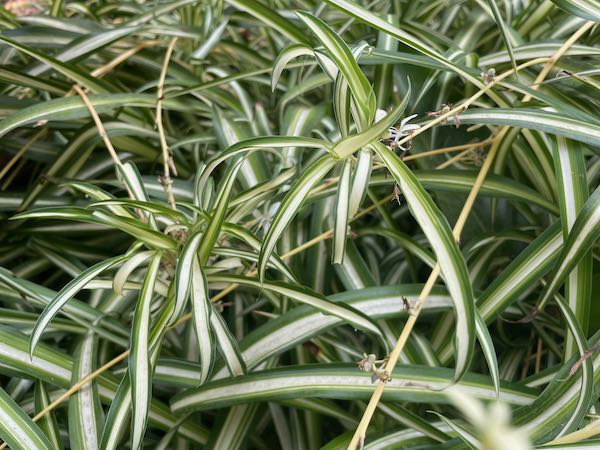Chlorophytum comosum, commonly known as Spider Plant, Spider Ivy, Ribbon Plant, or Hen and Chickens, is a tuberous perennial plant belonging to the Asparagaceae family. It originates from tropical and southern regions of Africa, where it thrives in its natural habitat.
The first description of Chlorophytum comosum was provided by the Swedish naturalist Carl Peter Thunberg, who initially named it Anthericum comosum in 1794. However, its classification was later revised, and it was officially assigned to the Chlorophytum genus by Jacques in 1862.
Known for its ease of growth and propagation, Chlorophytum comosum is a popular choice among plant enthusiasts. It typically reaches a height of about 60 cm or 24 inches, displaying long and slender leaves. These leaves feature a striking coloration, with a creamy-white center that gradually transitions to vibrant green edges. The plant produces delicate white flowers that appear on long branches and clusters, emerging at different intervals along the stem. Each flower consists of six tepals, adding an elegant touch to the overall appearance of the plant. Notably, the branches of Chlorophytum comosum carry small plantlets at their tips. As these plantlets bend over and make contact with the soil, they develop roots, facilitating easy propagation and giving rise to new plants.
How to grow Chlorophytum comosum:
Light and Shade Requirements: Provide Chlorophytum comosum with light shade. While it can tolerate a variety of light conditions, it generally thrives in bright, indirect sunlight. Avoid exposing the plant to harsh, direct sunlight, as it may scorch the leaves.
Soil Conditions: Plant Chlorophytum comosum in moist, well-drained soil. It prefers soil that retains some moisture but does not become waterlogged. Regular watering is essential to maintain proper soil moisture levels. Be cautious not to overwater, as this can lead to root rot.
Container Cultivation: Chlorophytum comosum is a favored choice for indoor container gardening. It adapts well to being potted and can thrive in a variety of container sizes. Ensure that the pot has proper drainage holes to prevent waterlogging.
Indoor Environment: When growing Chlorophytum comosum indoors, provide it with indirect sunlight. Place the plant near a window where it can receive bright, filtered light. Avoid exposing it to extreme temperature fluctuations.
Pest Control: Keep an eye out for common pests such as whiteflies, spider mites, scales, and aphids. Regularly inspect the plant for any signs of infestation and take appropriate measures to address them promptly. Maintaining proper humidity levels and regularly cleaning the leaves can help prevent pest issues.
Chlorophytum comosum, with its attractive foliage and easy-care nature, brings a touch of natural beauty to any indoor or outdoor space. Whether as a standalone specimen or a part of mixed plant arrangements, this resilient plant is sure to add charm to your surroundings. With proper care and attention, you can enjoy the lush greenery and cascading plantlets of Chlorophytum comosum for years to come.




